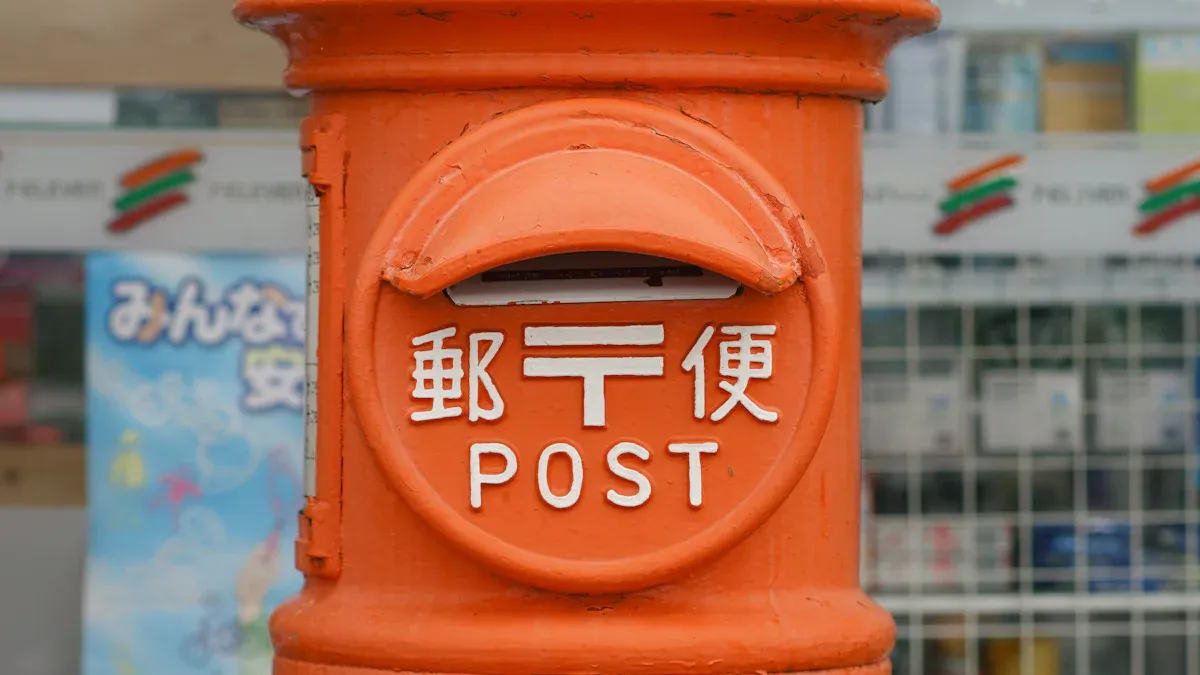- EasyCard
- Trade
- Help
- Announcement
- Academy
- SWIFT Code
- Iban Number
- Referral
- Customer Service
- Blog
- Creator
How to Fill in a Japanese Address? A Guide to Parcel Delivery and Precautions

Image Source: unsplash
Let’s first look at a standard Japanese address example.
〒100-8994 東京都中央区八重洲一丁目5番3号 東京中央郵便局 山田 太郎 様
This address follows the Japanese domestic “large-to-small” writing order. Correctly writing the address is a critical step to ensure smooth parcel delivery. Mastering how to write a Japanese address can effectively prevent delivery delays or lost parcels due to formatting errors, ensuring your intentions reach their destination accurately.
Key Points
- The order of writing a Japanese address is crucial: domestic shipping follows a large-to-small order, while international shipping follows a small-to-large order.
- The postal code and room number are key to ensuring accurate parcel delivery.
- International parcels must have the address written in English or Romaji, with accurate customs declarations.
- Before shipping, check the prohibited items list and package the parcel securely to prevent damage.
- The recipient’s name should be written in full, using the correct honorific, such as “様” or “御中”.
How to Write a Japanese Address: Step-by-Step Structure Breakdown
A complete Japanese address is like a puzzle, composed of several key components. As long as you understand the function and order of each part, you can easily construct an accurate delivery path. Below, we will break down the components of an address step by step to help you thoroughly master how to write a Japanese address.
Postal Code (郵便番号)
The postal code is the “first gate” of an address, critical for the postal service’s automated sorting.
- Format: Japan’s postal code consists of 7 digits, typically written as
〒XXX-XXXX. The〒symbol is the mark of Japan Post, representing mail. - Importance: An accurate postal code significantly speeds up parcel processing. Even if other parts of the address have minor errors, the correct postal code can help the post office locate the general area.
Tip: You can directly ask the recipient for the postal code or look it up on Japan Post’s official website by entering the address.
Prefecture (都道府県)
The prefecture is Japan’s highest level of administrative division, equivalent to a province in China. Japan has 47 prefectures.
- 1 Metropolis (To): 東京都 (Tokyo-to)
- 1 Region (Do): 北海道 (Hokkai-do)
- 2 Urban Prefectures (Fu): 大阪府 (Osaka-fu), 京都府 (Kyoto-fu)
- 43 Prefectures (Ken): The remaining 43 prefectures
When writing, you need to include the full name, such as “東京都”, rather than simply “Tokyo”.
Below is a complete list of the 47 prefectures for your reference.
| Prefecture (都道府県) | Reading (読み) | Romaji (ローマ字) |
|---|---|---|
| Hokkaido | ほっかいどう | hokkaidou |
| Aomori | あおもりけん | aomoriken |
| Iwate | いわてけん | iwateken |
| Miyagi | みやぎけん | miyagiken |
| Akita | あきたけん | akitaken |
| Yamagata | やまがたけん | yamagataken |
| Fukushima | ふくしまけん | fukushimaken |
| Ibaraki | いばらきけん | ibarakiken |
| Tochigi | とちぎけん | tochigiken |
| Gunma | ぐんまけん | gunmaken |
| Saitama | さいたまけん | saitamaken |
| Chiba | ちばけん | chibaken |
| Tokyo | とうきょうと | toukyouto |
| Kanagawa | かながわけん | kanagawaken |
| Niigata | にいがたけん | niigataken |
| Toyama | とやまけん | toyamaken |
| Ishikawa | いしかわけん | ishikawaken |
| Fukui | ふくいけん | fukuiken |
| Yamanashi | やまなしけん | yamanashiken |
| Nagano | ながのけん | naganoken |
| Gifu | ぎふけん | gifuken |
| Shizuoka | しずおかけん | shizuokaken |
| Aichi | あいちけん | aichiken |
| Mie | みえけん | mieken |
| Shiga | しがけん | shigaken |
| Kyoto | きょうとふ | kyoutofu |
| Osaka | おおさかふ | oosakafu |
| Hyogo | ひょうごけん | hyougoken |
| Nara | ならけん | naraken |
| Wakayama | わかやまけん | wakayamaken |
| Tottori | とっとりけん | tottoriken |
| Shimane | しまねけん | shimaneken |
| Okayama | おかやまけん | okayamaken |
| Hiroshima | ひろしまけん | hiroshimaken |
| Yamaguchi | やまぐちけん | yamaguchiken |
| Tokushima | とくしまけん | tokushimaken |
| Kagawa | かがわけん | kagawaken |
| Ehime | えひめけん | ehimeken |
| Kochi | こうちけん | kouchiken |
City, Ward, Town, or Village (市区町村)
This is the administrative level below the prefecture, including cities, wards, towns, and villages.
- City (Shi): Most addresses include a city name, such as
横浜市(Yokohama-shi). - Ward (Ku): In major cities like Tokyo’s 23 wards, Osaka, or Nagoya, the level below the city is a ward, such as
新宿区(Shinjuku-ku). - Town (Chō / Machi): A smaller administrative unit than a city.
- Village (Son / Mura): An even smaller unit, common in rural areas.
Recommended Tool: If you’re unsure about the exact kanji or level of a place name, you can use professional online databases. For example, CJKI’s “Japanese Multilingual Place Names and Points of Interest Database” covers detailed town and city area names in Japan, helping you verify information.
Chōme, Banchi, Gō (丁目・番地・号)
This is the most distinctive part of a Japanese address and where many people get confused. These three numbers together precisely locate a specific building. Mastering this part is key to understanding how to write a Japanese address.
| Element | Definition | Japanese Example | Romaji Example | Notes |
|---|---|---|---|---|
| Chōme (丁目) | A block or district within a town | 3丁目 (san-chōme) | 3-chome | Number first, indicating the district number. |
| Banchi (番地) | A lot number within a chōme | 3番地 (san-banchi) | 3-banchi | Number first, indicating the lot number. |
| Gō (号) | Building/house number | 13号 (jūsan-gō) | 13-go | Number first, indicating the building number within the lot. |
A complete format is 3丁目3番地13号. In daily writing and shipping labels, people often use hyphens (-) to simplify it.
3丁目3番地13号 => 3-3-13
This X-X-X format is very common; just fill in the numbers in order.
Building Name and Room Number
If the recipient’s address is an apartment, complex, or company, this part must not be omitted.
- Apartment/Residential: Typically includes the building name and room number, e.g.,
〇〇マンション 101号室(〇〇 Apartment, Room 101). - Office Building: May include the building name and floor, e.g.,
〇〇ビル 5F(〇〇 Building, 5th Floor).
Missing the room number is one of the most common reasons for delivery failures, as couriers won’t know which unit to deliver to.
Recipient Name and Honorific (様)
Finally, and most importantly, you need to include the recipient’s name.
- Name: Always use the recipient’s full name, ideally matching the name on their Japanese ID (e.g., residence card). This is especially critical for international parcels requiring customs clearance.
- Honorific: In Japan, writing only the name is considered impolite. You need to add an honorific after the recipient’s name.
The table below lists the most commonly used honorifics and their uses:
| Honorific | Usage | Example |
|---|---|---|
| 様 (sama) | The most universal honorific, used for individuals regardless of status. | Taro Yamada 様 |
| 御中 (onchū) | Used for organizations or groups like companies or schools, not specific individuals. | ABC Corporation Sales Department 御中 |
| ご担当者様 | Used when you don’t know the specific recipient’s name but are addressing someone in a department. | ABC Corporation Sales Department ご担当者様 |
Using the correct honorific not only ensures smooth delivery but also reflects respect for Japanese culture.
Pre-Shipping Preparation: Customs and Packaging
Before sending your parcel, there are a few critical steps to complete. Proper customs declaration and secure packaging are essential to ensure your parcel crosses borders smoothly and arrives intact.
Customs Declaration Form
All international parcels from mainland China to Japan must include a customs declaration form (e.g., CN22 or CN23). This form informs Japanese customs about the contents of your parcel.
You need to clearly provide the following information:
- Content Description: Describe each item in detail in English or Japanese. For example, instead of just writing “Gift,” write “1 Cotton T-shirt, 2 Books.” The clearer the description, the faster the customs clearance.
- Quantity and Value: Accurately list the quantity and value of each item. Values typically need to be declared in USD.
- HS Code: Some items require an international Harmonized System (HS) code, which you can look up on relevant websites.
- Signature: Always sign and date the form. An unsigned declaration is invalid.
Important Note: Accurate declaration is your legal responsibility. Underreporting or omitting items may lead to the parcel being detained, returned, or destroyed.
Common Prohibited Items List
Japan Customs has strict regulations on imported items. Before shipping, confirm that your parcel does not contain prohibited items. Below are some common restricted or prohibited items:
- Meat Products and Fresh Produce: All meat products (including jerky, sausages), most dairy products, and many fresh fruits and vegetables (e.g., apples, mangoes) are prohibited.
- Counterfeit and Pirated Goods: Fake goods or pirated media violating intellectual property rights are strictly banned.
- Certain Medications: Many over-the-counter drugs common in mainland China, such as those containing pseudoephedrine (e.g., some Contac or DayQuil) or codeine-based cold or cough medicines, are prohibited in Japan. Personal prescription drugs are typically limited to a 1-month supply, and over-the-counter drugs to a 2-month supply. Additional procedures are required for exceeding these limits or mailing special medications.
- CITES-Related Items: Ivory, certain reptile leather products, and other animal or plant products protected by the CITES international convention are also prohibited.
Proper Parcel Packaging
During long-distance shipping, parcels may experience bumps and pressure. Sturdy packaging is essential.
- Choose the Right Box: Use a slightly larger, sturdy new cardboard box. Avoid using damaged old boxes.
- Adequate Cushioning: Wrap each item individually with bubble wrap, foam peanuts, or crumpled newspaper, and fill all empty spaces in the box. Gently shake the box to ensure items don’t move.
- Double Packaging: For highly fragile items like ceramics or glass, use a “box-in-box” method. Wrap the item in cushioning material, place it in a smaller box, then put that box into a larger box filled with more cushioning.
- Secure Sealing: Use wide packing tape in an “H” pattern to seal all box openings, ensuring it won’t accidentally open during transit.
International Shipping Address Format (From Abroad to Japan)

Image Source: unsplash
When sending a parcel from mainland China or other countries to Japan, the address writing format is the complete opposite of Japan’s domestic convention. You need to use English or Romaji and follow the international “small-to-large” order. This section will detail how to write a Japanese address for international shipping.
English/Romaji Writing Standards
To ensure recognition by non-Japanese postal systems, international mail addresses must be written in Roman letters.
- Romaji: This is the system of transcribing Japanese kana into Roman letters. You need to convert each part of the Japanese address into Romaji.
- Full Prefecture Name: Although systems like ISO 3166-2:JP exist, there is no standardized abbreviation for practical mailing. To avoid confusion, the safest approach is to write the full prefecture name, e.g.,
Tokyo-to,Osaka-fu,Hokkaido.
Address Writing Order (Small to Large)
The international address order is the reverse of the Japanese format. You start with the smallest unit (room number) and end with the largest (country).
International Format Example: Taro Yamada Tokyo Chuo Post Office, 101 1-5-3 Yaesu, Chuo-ku Tokyo-to 100-8994 JAPAN
This order ensures the parcel is processed correctly by postal systems before reaching Japan.
International Shipping Label Example
When using international couriers like EMS or DHL, you need to fill in the address details in the corresponding fields. Below is a general guide.
| Label Field | Example Content | Notes |
|---|---|---|
| To / Recipient | Taro Yamada | Recipient’s full name |
| Address Line 1 | Tokyo Chuo Post Office, 101 | Building name and room number |
| Address Line 2 | 1-5-3 Yaesu, Chuo-ku | Chōme-Banchi-Gō and city/ward/town/village |
| City | Tokyo | City name |
| State/Province | Tokyo-to | Prefecture |
| Postal Code | 100-8994 | Postal code |
| Country | JAPAN | Country name |
| Phone | +81 90-1234-5678 | Must include Japan’s country code +81 |
Sender Information Placement
The sender’s information (your details) is typically filled in the “From” or “Shipper” section of the shipping label. Use English or Pinyin to write your address, ensuring it includes your country name (e.g., CHINA) and contact phone number. This ensures the parcel can be returned to you if it cannot be delivered.
Domestic Shipping Address Format in Japan

Image Source: unsplash
If you are in Japan and need to send a parcel to a friend within the country, the address writing rules revert to Japan’s traditional format. You need to use Japanese kanji and follow the “large-to-small” order, which is completely different from the international format.
Japanese Kanji Writing Standards
For domestic shipping in Japan, addresses are typically written in Japanese kanji. You need to ensure the kanji for place names and the recipient’s name are accurate. Regarding writing direction, you have two options:
- Horizontal Writing (横書き): This is the most common method today, written from left to right, aligning with modern reading habits. Shipping labels and online shopping websites generally use this format.
- Vertical Writing (縦書き): This is the traditional Japanese writing style, with characters written from top to bottom and columns from right to left. You may still see this format on envelopes or postcards.
Address Writing Order (Large to Small)
The order for domestic addresses in Japan is logical and clear, like zooming in from a large map to a specific door. The correct order is key to ensuring smooth sorting and delivery.
- Postal Code (郵便番号): Always placed first.
- Prefecture (都道府県)
- City/Ward/Town/Village (市区町村)
- Chōme-Banchi-Gō (丁目・番地・号)
- Building Name and Room Number
- Recipient Name + Honorific (様)
Complete Example: 〒100-8994 東京都中央区八重洲1-5-3 東京中央郵便局 101号室 山田 太郎 様
Domestic Shipping Label Example
When using services like Yamato Transport (ヤマト運輸) or Japan Post (日本郵便), you need to fill out a shipping label (伝票). The label typically has clearly divided fields.
- Recipient (お届け先): Fill in the recipient’s postal code, address, name, and phone number here.
- Sender (ご依頼主): Fill in your own information here.
- Item Description (品名): Briefly describe the parcel’s contents, e.g., 「書籍」 (books), 「衣類」 (clothing).
Simply follow the prompts on the label to fill in the address information in the “large-to-small” order.
Handling Special Addresses
Sometimes, the recipient’s address may not be a standard residence. Learning how to write a Japanese address includes handling these special cases.
- Sending to a Company or School: Write the organization name first, followed by the department and individual name.
- Single-Family Homes Without Room Numbers: The address ends after completing the
Chōme-Banchi-Gō.
The table below shows how to handle addresses for companies:
| Scenario | Example |
|---|---|
| To an entire company | ABC Corporation 御中 |
| To a company department | ABC Corporation Sales Department 御中 |
| To an employee in a department | ABC Corporation Sales Department Taro Yamada 様 |
Correctly using 御中 (for organizations) and 様 (for individuals) is an important etiquette.
Now, let’s summarize the key points for sending parcels to Japan:
- Prepare for Customs: Accurately filling out the declaration form can effectively prevent customs delays.
- Follow Address Order: International shipping (from abroad to Japan) is small-to-large; domestic shipping in Japan is large-to-small.
- Verify Key Information: The postal code and room number are critical for precise delivery and are common sources of errors, so double-check them.
As long as you follow the steps in this guide, you can easily complete parcel shipping, ensuring your intentions arrive accurately.
FAQ
What if the X-X-X numbers in the address are incomplete?
Simply fill in the information provided. If the address only has 1-23, it typically represents 1丁目23番地. You don’t need to fill in missing numbers. Keeping the order correct is key.
Can I write the address entirely in English when sending from mainland China?
Yes, you must do so. When sending from non-Japanese-speaking countries like mainland China, the address must be written in English or Romaji. This ensures the parcel is processed correctly by postal systems before reaching Japan.
Can I use a nickname or English name for the recipient?
We strongly recommend using the recipient’s legal full name (matching their ID). This is especially important for international parcels requiring customs clearance. Using nicknames or incomplete names may lead to the parcel being detained or undeliverable.
*This article is provided for general information purposes and does not constitute legal, tax or other professional advice from BiyaPay or its subsidiaries and its affiliates, and it is not intended as a substitute for obtaining advice from a financial advisor or any other professional.
We make no representations, warranties or warranties, express or implied, as to the accuracy, completeness or timeliness of the contents of this publication.




Contact Us
Company and Team
BiyaPay Products
Customer Services
is a broker-dealer registered with the U.S. Securities and Exchange Commission (SEC) (No.: 802-127417), member of the Financial Industry Regulatory Authority (FINRA) (CRD: 325027), member of the Securities Investor Protection Corporation (SIPC), and regulated by FINRA and SEC.
registered with the US Financial Crimes Enforcement Network (FinCEN), as a Money Services Business (MSB), registration number: 31000218637349, and regulated by FinCEN.
registered as Financial Service Provider (FSP number: FSP1007221) in New Zealand, and is a member of the Financial Dispute Resolution Scheme, a New Zealand independent dispute resolution service provider.


















